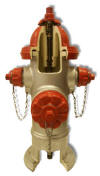|
Displayed above is a sampling of fire hydrants
and salesmen samples from our collection. It is not exactly known
when fire hydrants were first invented or who specifically invented
them. Basically, it has been a work in progress since the late
1600's. It was not until 1801 that the fire hydrant that sticks
out of the ground came about. These type of hydrants were drilled
into the wooden water mains of their time. Eventually the wood
water mains were replaced by the cast iron mains of today.
When looking at a typical fire hydrant you may notice
four main things about it. First it looks like a large pipe
sticking out of the ground, this is the 'barrel' of the hydrant.
The second thing you may notice is that it has 1, 2, 3, or more outlets
sticking out of the barrel. These outlets are where the fire
fighters attach their hoses. Third, is the top 'hat' or the
bonnet. The last major feature of the hydrant
is the large bolt that sticks out of the top, this is called the valve
stem. This is how the fire
fighters turn the water on and off. Except in warm climates, the
water does not run up into the hydrant, it stays down in the main.
This is done to prevent the water that would be in the hydrant from
freezing. This valve stem runs down the barrel and under the
ground into a valve that is directly above the water main, when the bolt
is turned the water flows into the hydrant. You may have also
noticed that the valve stem and the outlet covers are not standard
wrench shape. They are made in a pentagonal shape (five sides).
This is a tamper feature that tries to keep people other than fire
fighters, who have special wrenches, from opening the hydrants.
All of these hydrants
were restored by our in house restoration team. When an
un-restored fire hydrant comes in, the first thing our restoration team
does is cut off the pipe that connected the hydrant to the water main.
The next step includes disassembling the unit, every nut and bolt is
undone and every chain is unlinked. This is so the unit can be
properly sandblasted. After all of the old paint and rust is
removed by the sandblasting, the unit is primed, painted and reassembled. In addition to these steps, all of
our units are mounted on to a three-quarter inch piece of steel for
stability.
|
|
 |
These two fire hydrants are salesman samples, miniature versions of the real thing, with cut away sides. Rather
than carry a full sized hydrant that might weigh a hundred or two
pounds, the salesman easily carries a sample that only weighs about 4
pounds. The cut away sides allows the salesman to demonstrate how
the hydrant operates |
 |